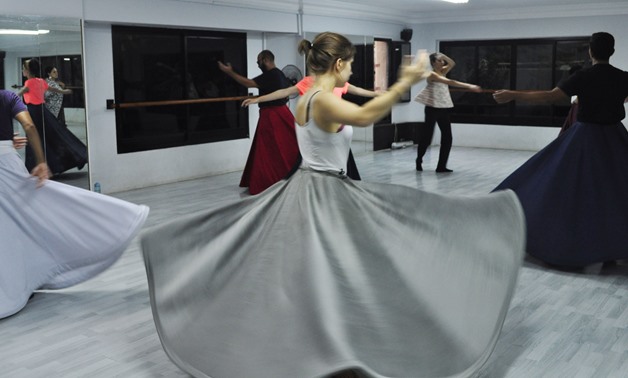
Ziya Azazi (Photo courtesy of Ziya Azazi official Facebook page)
CAIRO – 23 October 2017: Dance was always meant to be staged by humans as a medium that liberates them from their emotional and mental status. Egypt Today speaks to Turkish Sufi dancer Ziya Azazi who reveals a world of liberty by whirling and spinning.
Establishing his dancing career in the late 90s, Azazi pioneered the experimental whirling and repetition that reflects an artistic and motional analysis of Sufi dance. He conducted workshops in which he taught participants how to reach a high state of physical awareness and ecstasy.
 Dervish in progress (Photo courtesy of CCDC media office)
Dervish in progress (Photo courtesy of CCDC media office)
Through this state, a dancer would be able to examine mental transformations that derive from speed and tension attributed to spinning. Azazi visited Egypt in September to hold workshops at Cairo Contemporary Dance Center (CCDC) including Dervish in Progress and Dervish Tango.
ET: How did the workshop help in allowing participants create their own genre?
ZA: Spinning is one kind of dance used mainly by Sufi dancers and that’s what Egypt calls “Tanoura” dance. Whirling is more ancient than you think and you may see it in various cultures in South America.
Whirling is used in contemporary dance as a tool for the dancer to recognize and be aware of themselves. In our daily lives we act as shallow versions of ourselves, but when we start to spin we dive deeper through our souls. That requires daily hard work however. In the end, spinning liberates the body and makes us seek better lives.
ET: How did participants react to the Dervish in Progress workshop?
AZ: They were interested and keen to try it. Spinning is not traditional here because we merge it with contemporary aspects. The adaptation was hard at first but it was manageable in the end. Participants in this workshop were able to master it because they are emotional. In spinning we need to be able to mediate our emotions and master our abilities.
 Dervish in progress (Photo courtesy of CCDC media office)
ET: How does Dervish in Progress and Dervish Tango differ?
AZ:
Dervish in progress (Photo courtesy of CCDC media office)
ET: How does Dervish in Progress and Dervish Tango differ?
AZ: Dervish in Progress was meant to develop the traditional concept of spinning such as the Egyptian Tanoura. In other words, the workshop managed to enhance the ancient form of spinning. Development included merging other movements and forms into whirling such as jumping, whirling on the floor or without the skirt, fast, slow, or with different body postures. We progress the spinning and tradition, which is why it is called Dervish in Progress.
Dervish Tango is where spinners learn how to become social and dance with a partner, they master how to be compatible with each other and understand their body language. One person leads and the other follows. While teaching spinning, I try to integrate physical, mental and emotional communication and tango was the best option.
ET: How do you assess the current oriental Sufi dance in Egypt and the Arab World?
AZ: I have been performing for almost 18 years and taught in different countries. There are different interpretations of Sufi dance around the world. Egypt has different costumes and tradition but when we observe all forms of spinning in the world, we’ll notice that the art of spinning has common aspects in repetitive sound, rhythm and behavior operating on the mind and body with the same purpose.
 Ziya Azazi (Photo courtesy of Ziya Azazi official Facebook page)
ET: What are your upcoming projects?
AZ:
Ziya Azazi (Photo courtesy of Ziya Azazi official Facebook page)
ET: What are your upcoming projects?
AZ: In the coming month I will hold workshops in Spain, Romania, Bulgaria, Italy, Turkey, and Austria. I also have several performances that will run in parallel with each other including Dervish in Progress, More Dervish, and a new creation that is currently being finalized called “El Qesma” (Destiny).
ET: How is whirling common to contemporary dance?
AZ: Contemporary dance has many different languages and forms, so every artist has their own language and presentational form. Contemporary dance varies in formats but if one format of contemporary is based on repetition, abstract, and movement without trying to be socially critical and merely focuses on movement, then this contemporary dance is close to characteristics of Sufism and is able liberate individuals.
 Ziya Azazi (Photo courtesy of CCDC media office)
Ziya Azazi (Photo courtesy of CCDC media office)
Azazi’s recent workshops conducted in Egypt were inspired by whirling dervish techniques, tango, and a hint of contemporary dance. Azazi has participated in several festivals including Liteside in Amsterdam, Danse en Ville in Brussels and Festival de Solos y Duetos, among others.




Comments
Leave a Comment